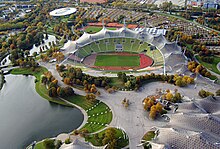Stromeyer (company)

The Stromeyer company was active in the textile industry.
history
Ludwig Strohmeyer and Julius Landau founded in the April 16, 1872 Romanshorn in the Swiss canton of Thurgau , the tent factory Landauer & Strohmeyer. In 1873 the company was relocated to Münzgasse in Konstanz in order to be present on the German market. In addition, waterproof fabrics were produced and dyed on a 4000 m² site at the Konstanz gas works. The main buyers of these fabrics were the railways and the military. In 1878 the company started manufacturing large circus tents and opened a weaving mill in Weiler im Allgäu . In the same year co-founder Landauer left the company, but three years later the company name (company) in was L. Strohmeyer & Co. changed. In 1885 a 150,000 m² site was bought on the Seerhein in Constance and a factory was built that gave its name to the Stromeyersdorf district. In the period that followed, branches were set up in Hüfingen , Kreuzlingen , Mannheim , Markdorf and Überlingen . Around 100 employees worked in Konstanz at the turn of the century.
In 1910 a fire destroyed parts of the factory. During the reconstruction and expansion, the water tower, which is now a listed building, was built for the supply of process and extinguishing water. The structural design that had shaped the Stromeyersdorf company premises to the end was created between 1905 and 1925. With Philipp Jakob Manz (1861–1936), the company had won one of the leading industrial architects for it.
Between August 22, 1923 and January 15, 1924, the company issued around 57,000 emergency notes with values ranging from 100,000 to 20 billion marks. The good order situation made it possible for a total of 800 people to work for Stromeyer in 1929. In particular, the armament of the Wehrmacht brought further momentum to business. After the collapse of the “ Third Reich ”, the French occupiers dismantled part of the machine park.
The economic miracle brought Stromeyer good business and renowned projects. Among other things, the employees were responsible for the textile structures during the 1972 Summer Olympics . In addition to new, large-format canvas constructions, the company placed itself on the market with pneumatically expandable sports and industrial halls. The 1973 filing for bankruptcy was all the more unexpected . The procedure lasted over eight years and was the longest procedure in the Federal Republic up to that point. Production in Germany continued until the end of 1984. The final liquidation came in 1986. Stromeyer Innovation GmbH, based in Radolfzell , continued as a decoupling until 1990. Then the company Mehler, also active in the textile and camping business, acquired this company. Mehler now sold the tent business under the name Mehler Stromeyer Camping GmbH. The end of this company in Radolfzell followed in 2000, with the division for black tents of the German boy scout and youth movement being given up. Former Stromeyer employees then founded the company Tortuga in Radolfzell , which continues to this day with camping tents as well as the Stromeyer production of black tents under a new name, which was started before the Second World War.
In 1998 Mehler acquired the Czech company Technolen technicky textil sro from Lomnice nad Popelkou, which was founded in 1908 . There Mehler had tents marketed under the Stromeyer brand. Stromeyer is now a manufacturer's brand of Technolen and is still a subsidiary of Mehler today. Since the majority of the shares in Mehler was taken over by the holding company KAP AG in 1997/98, Technolen also belongs to this consortium . The new beginning of Technolen and the also Czech textile manufacturer Texlen in 2007, to gain a foothold again with black tents under the name Stromeyer in Germany, was accompanied by Protect GmbH from Essen . This venture was unsuccessful, so the Scout and Youth Movement division was abandoned after 2009.
Neuwerk eG
After the bankruptcy, the factory premises in Konstanz were briefly empty. In the meantime, the site belonged to the Federal Property Office . In 2000 the Neuwerk cooperative bought the hundred-year-old building of the former Stromeyer tent factory. It was fundamentally renovated and expanded by 2005. Today trade, handicrafts, hobbies, art and culture are united under one roof on around 9000 m².
Products and projects
Stromeyer products included tents (especially circus tents), canopies, tarpaulins and awnings, blankets, clothing, rucksacks and the structural planning of large tent projects.
Known large tent projects were in 1912 for the Sängerbundfest in Nuremberg created, 20,000 people comprehensive large tent, in 1967 the German pavilion of the EXPO Montreal , 1967-1972 with Frei Otto constructive planning for the roofing of the Olympic Stadium in Munich , 1970 the tent roof of the Nature Theater Luisenburg stage in Wunsiedel , and in 1975 the round tent built in Uganda with a diameter of 40 meters as a tent church.
Web links
- "Ludwig Stromeyer: A career in Constance", published by Warndorf Konzept, Text & PR on November 2nd, 2009
- Stromeyer Hallen website
- Stromeyer Planen website
Individual evidence
- ↑ Dr. Jens-Uwe Rixen: Emergency money issues in the Baden Lake Constance area 1914-1948 , section 12 Konstanz, L. Stromeyer and Co. In: "HEGAU", Volume 41/42, Singen (Hohentwiel) , September 1986.


